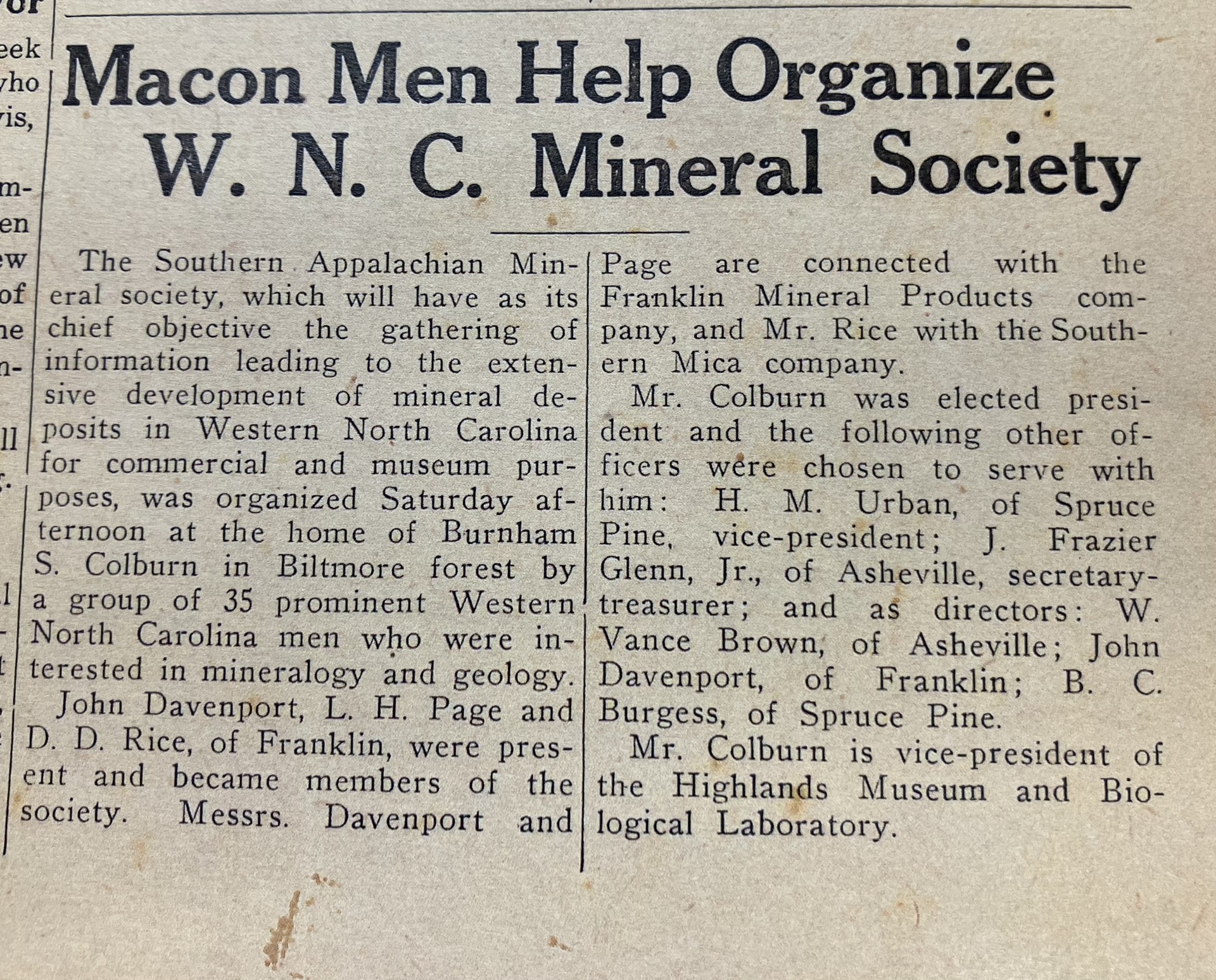
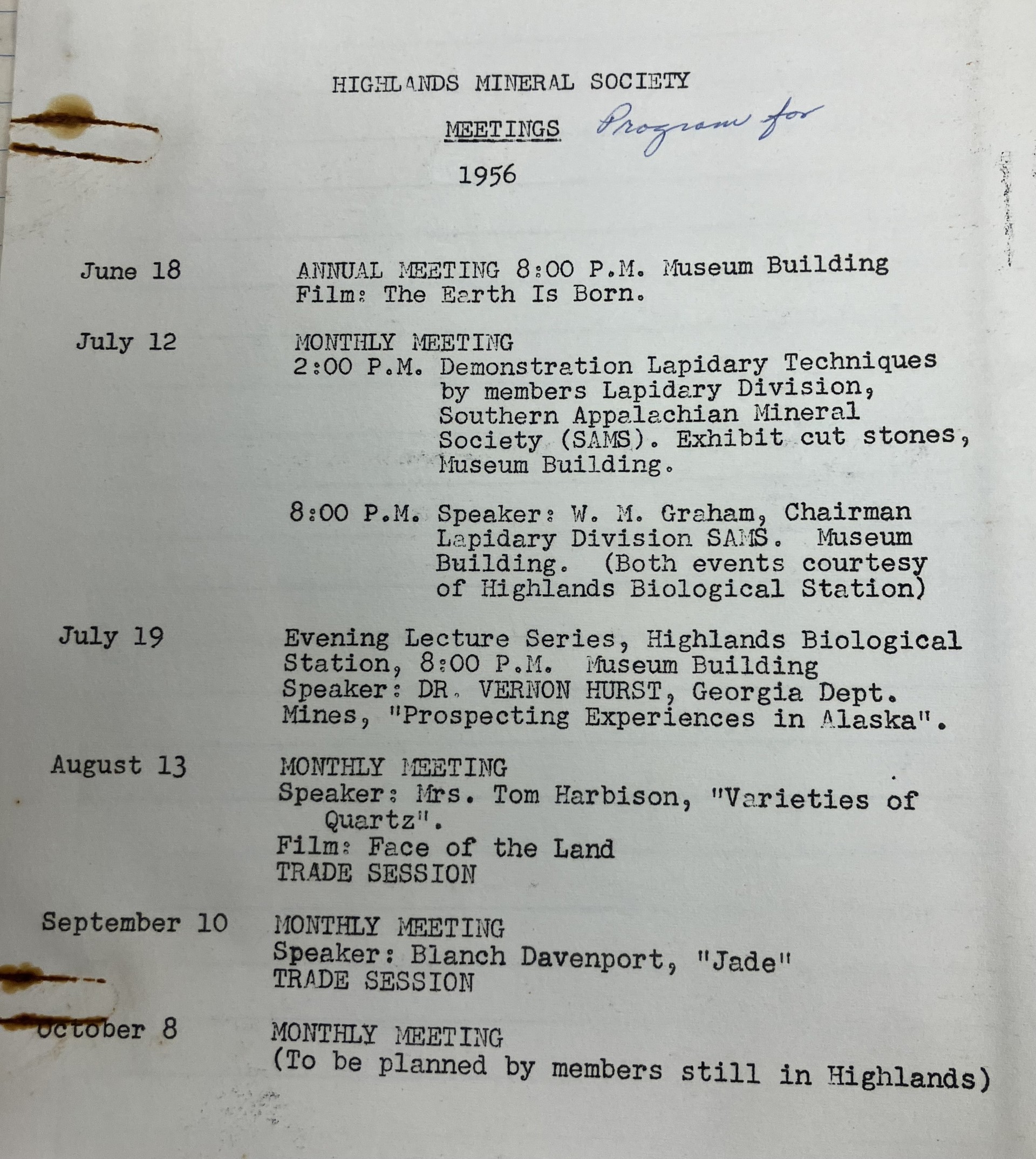
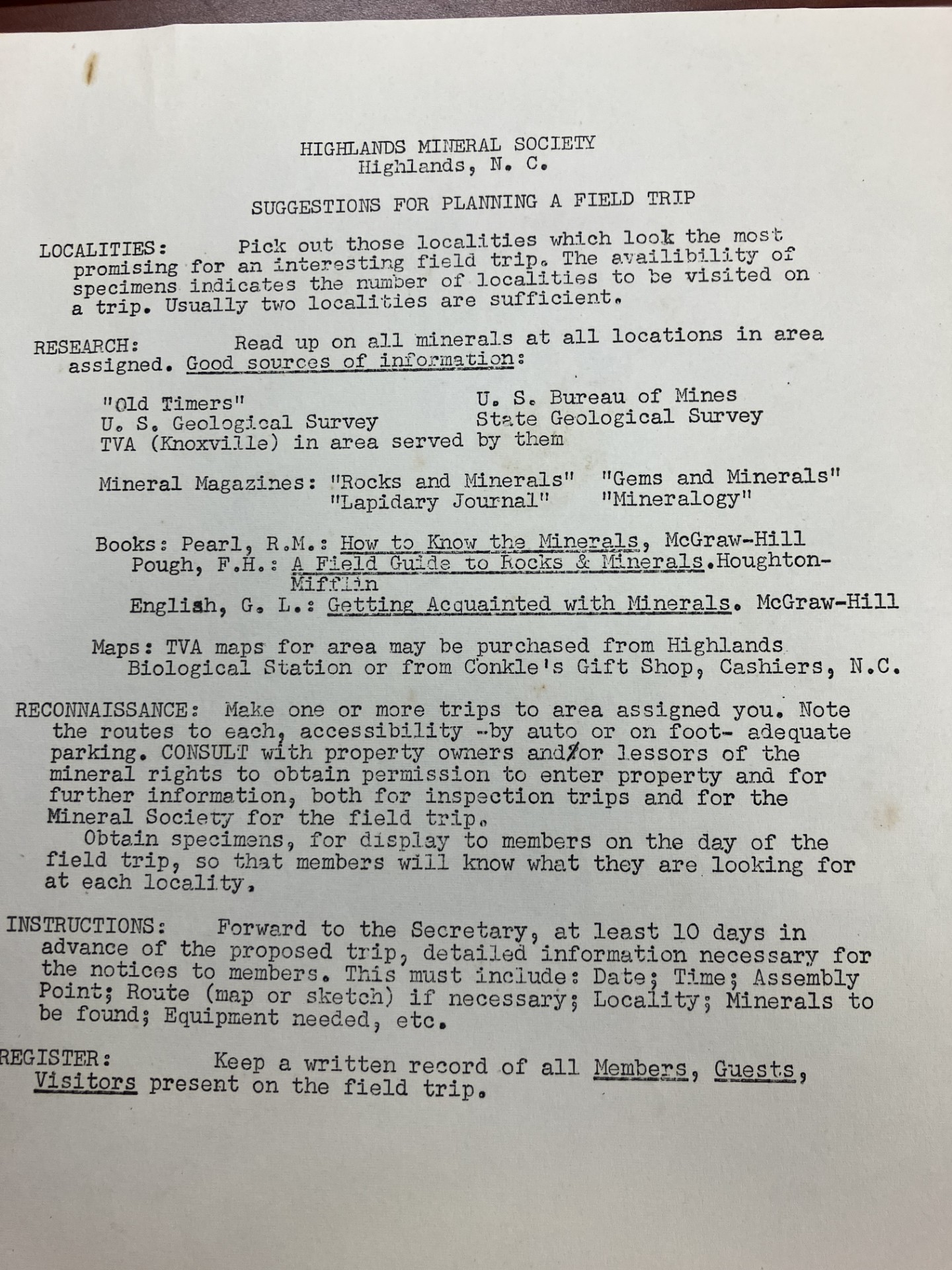
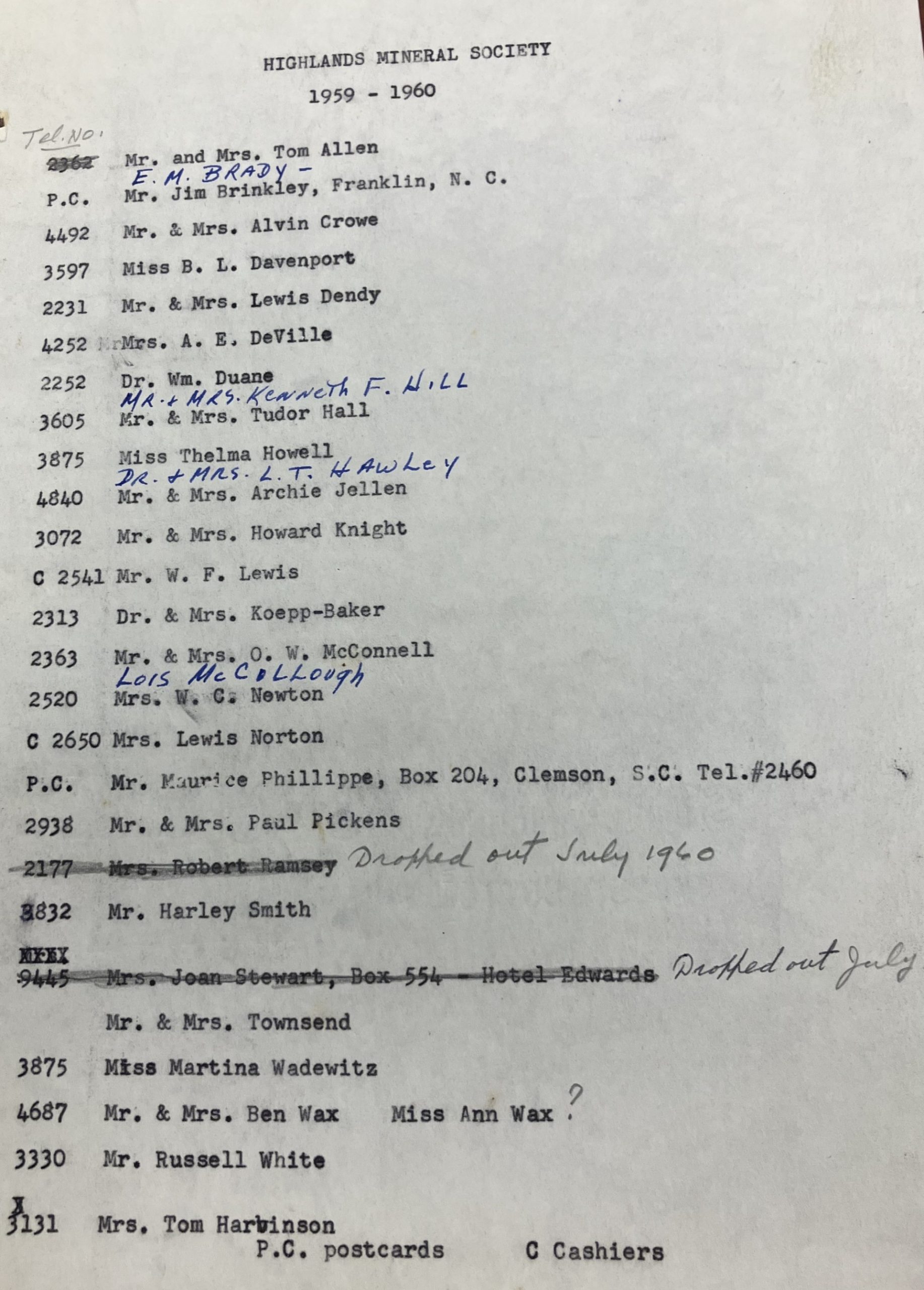
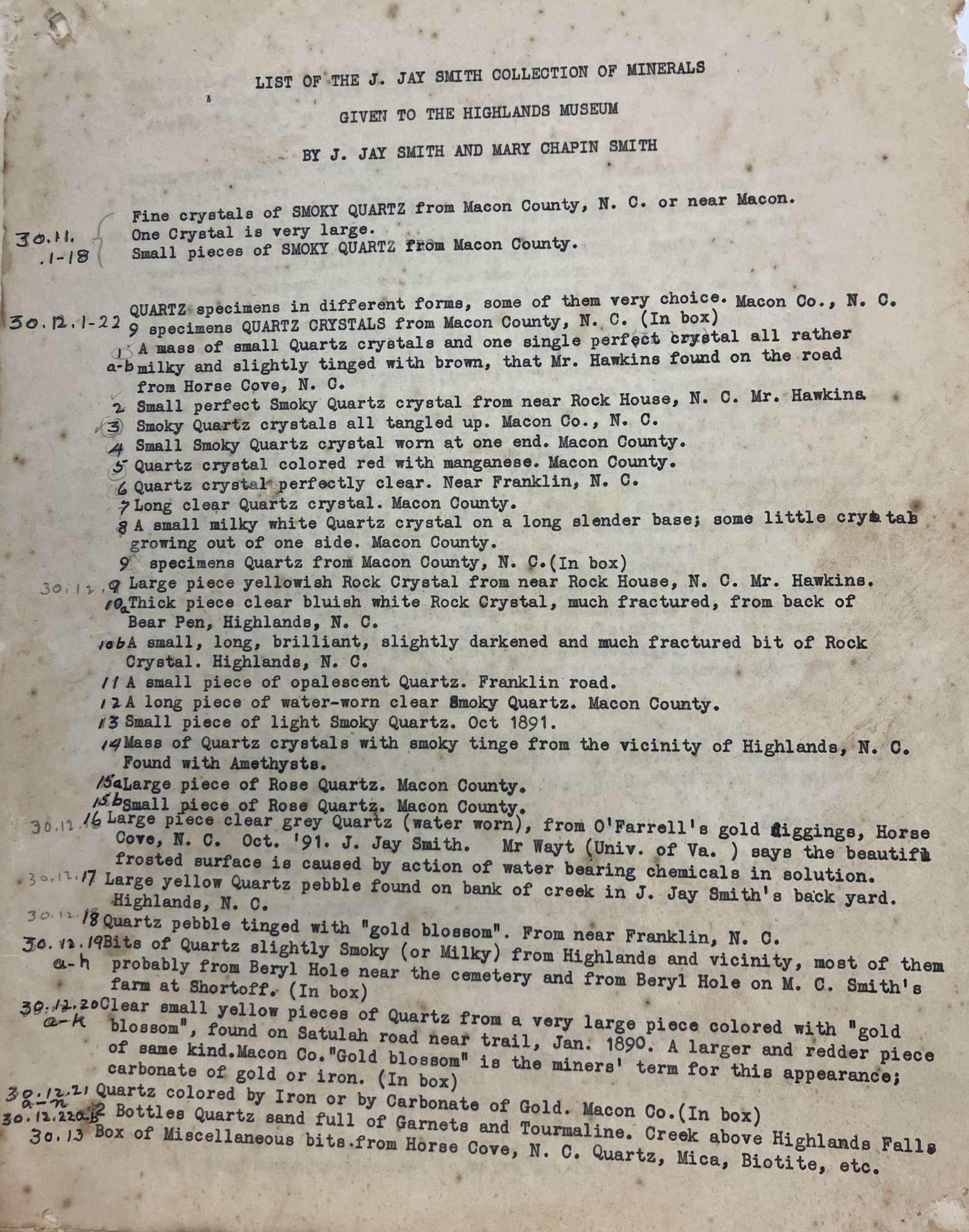
On April 8, 1931, The Highlands Maconian reported that the Southern Appalachian Mineral Society had been organized, “leading to the extensive development of mineral deposits in Western North Carolina for commercial and museum purposes.” The Society was established at the Asheville home of Burnham S. Colburn, Vice-President of the Highlands Museum and Biological Laboratory. John Davenport and L. H. Page of Franklin Mineral Products, along with D. D. Rice of the Southern Mica Company, became members, along with other men interested in geology.
On June 12, 1956, the Highlands Mineral Society was formally created by Constitution and By-Laws, with 30 members noted. The Society’s purpose was “to promote popular interest and education in various earth sciences, in particular mineralogy, distribute information on lapidary techniques, and encourage good fellowship.”
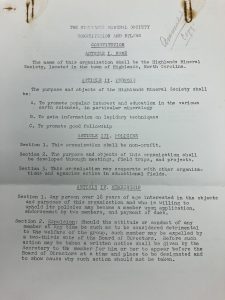
Society Minutes
The Society’s records from 1955 until its disbandment in 1962 are preserved in the E. E. Reinke Library archives at the Highlands Biological Station.
Minute Book #1 (1955–1957) notes that the first meeting was held on July 6, 1955, chaired by Dr. Thelma Howell at the Highlands Museum. Howell asked Judge George Janvier to preside, and officers were elected: President Frank Binz, Jr. and Secretary/Treasurer Mrs. Tom (Elizabeth) Harbison. Dues were set at $1, later raised to $2. On July 17, the first field trip was led by Dr. Howell and Lewis Dendy. Children were not permitted on trips, and participation was at one’s own risk.
On June 4, 1956, the newly elected President, Frank Binz, died. At the next meeting, his service to the Mineral Society was honored with a prayer. Lewis Dendy became the new President. In 1957, a display case was purchased for the Highlands Museum in Binz’s memory, where minerals were exhibited.
Meetings generally consisted of minutes, committee reports, and a program with door prizes and refreshments. Programs included topics such as: Classification of Rocks, Fluorescence, Physical Properties of Minerals, Emeralds, Crystallography, Radioactive Minerals, Cat’s-Eye Sillimanite, and Varieties of Quartz.
Field Trips
From 1955 to 1961, members received field trip notices listing locations and possible mineral finds. Sites included Blue Valley, Holbrook Mine, Horse Cove, Laurel Creek, Queen Mountain, Sheep Cliff Feldspar Mine, and Whiteside. Each trip was documented with an information sheet and signature list of attendees and their addresses.
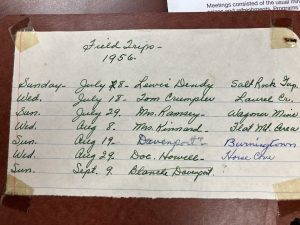
Membership
Membership ranged from 20 to 62 during the Society’s seven-year history. Records from 1959–1960 show members’ names alongside four-digit telephone numbers. Other lists also recorded members’ winter addresses.
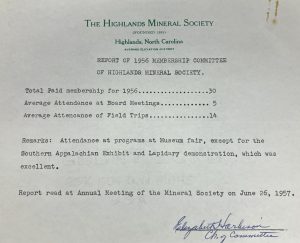
The Highlands Mineral Society was officially disbanded at a called meeting on August 17, 1962, “due to lack of interest and attendance by members.” The remaining $174.63 in the treasury was donated to the Highlands Museum to purchase additional chairs for the auditorium.
The Mineral Collection at the Highlands Biological Station (HBS)
Despite the Society’s disbandment, rocks and minerals had been part of the Highlands Museum since July 1928, when they first appeared in the accession book. Notable donations came from Marguerite Ravenel (1949), Louis Denby, Burnham S. Colburn, and the Jellens. Major collections were later contributed by the Smiths, Harold Mallory, and Thelma Howell.
J. (John) Jay (1853–1941) and Mary Chapin (1855–1940) Smith Collection
This collection, donated in 1930, included quartz, beryl, and corundum from Macon County, as well as agates, jasper, chalcedony, flints, gold ore, and calcium from other localities. The Smiths were early pioneers in Highlands. J. Jay Smith was an entrepreneur, road and bridge builder, and woodsman who owned the first steam sawmill producing lumber for many Highlands houses. Mary Chapin attended the founding meeting of the Station in August 1927, became a trustee, and remained actively involved with the Museum and Laboratory for many years.
Harold B. Mallory (1901–1977)
Mallory donated his collection between 1969 and 1976. It was last appraised by the Highlands Gem Shop in 1991. The gems were not local but had been collected worldwide. Mallory lived in New Smyrna Beach, Florida, and summered in Highlands. The Highlands Gem Shop, owned by Archie M. and Hazel S. Jellen—members of the Highlands Mineral Society from 1958 to 1962—was established in 1952 and is closing this year after 73 years in business.
Thelma Howell (1901–1979)
Howell’s gem collection was given to the Station in 1981 by her great-nephew, Dr. Charles W. Styron, from her estate. The collection was appraised by the Jellens in 1983, and a raffle drawing was held on September 3, 1983. The winner was Howell’s dear friend and long-time Station assistant, Martina Haggard. A total of $1,638 was raised for the Thelma Howell Memorial Scholarship at HBS.
Mineral Societies in Western North Carolina
Mineral societies have long been of interest in Western North Carolina due to the region’s many mineral mines. Today, Franklin, NC is known as the “Gem Capital of the World,” hosting one of the largest annual rock and mineral shows, the “Macon County Gemboree,” which features dealers from around the globe.
Cataloging of the HBS Rock and Mineral Collection
This past summer, students from Western Carolina University’s Geology Department, led by Dr. Cheryl Waters-Tormey and Dr. Shane Schoepfer, cataloged the Highlands Biological Station’s mineral collection. University Program Associate Sarah Vickery reflects on their work and shares insights from their time on campus in a featured essay.
– Bryding Adams, Volunteer Archivist, October 2025
